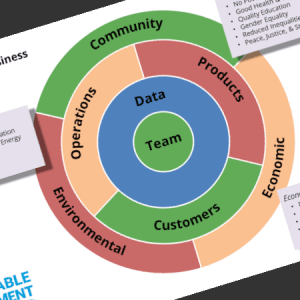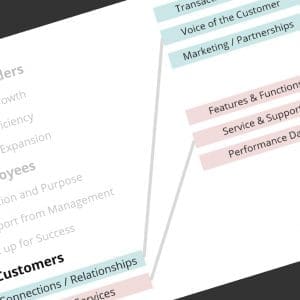Each functional area in your company needs to understand the skills and strengths that they bring to a Digital Transformation effort; why do they deserve a “seat at the table”? Next up is the IT team - with their hands-on applied technology skills and experience in collaboration environments, IT can and should play a critical role. (part of a series)
There is an interesting phenomenon at many companies that are looking at new and different ways to incorporate information and technology into the various components of their Great Digital Business. There is a certain leap of faith (or hope) that the new and different steps in this journey will be easy – an extrapolation of our experience with internet search (thousands of answers from a simple question) and apps on smartphones (one click installation, connected to everything, and so easy to use). But when things get a teeny bit complicated, the local IT department is called in.
I do not suggest that IT has an obvious, critical, strategic position of power here – on the contrary, most of the time IT is called in fill in the gaps when the “simple instructions” reach their limit. These aren’t conversations about architecture, process, or governance; this is “calling in the local techie to fix my problem”, not technology-savvy professionals contributing towards strategic approach and tactical progress.
How does your IT team department break out of this supporting role, and take a more active role as equal parts of a great team? An important way to get their attention is to focus on your critical strengths in each of the five components of your Great Digital Business, and understand the biggest impact that you bring to the table. Just as with the other functional areas, there are simple, powerful ideas to focus your team.
- Communicating Complexity: In most businesses, the IT department is your best source for project managers – especially for complex initiatives that impact multiple areas of the enterprise, and require precision and coordination for technology-enabled processes. Most companies can identify with the big ERP implementations or upgrades – multi-headed projects managed with the classic Waterfall method, and typically involving internally-focused functions like Operations and Finance who must commit time and effort for a lot of one-time effort that they may not fully understand. At the other extreme, we see diverse teams in Marketing, Creative, and Analytics teams using an Agile approach – with cute buzzwords like Scrums and Sprints, but an excellent focus on keeping the chunks of work small while iterating repeatedly to make sure the changes will fit the needs. Call it what you will, but in the end, all project management methodologies hie to the same primary objective – manage expectations and communicate across a complex web of stakeholders and participants. And this is where IT can make a huge difference – leveraging your experience in managing complexity, and communicating out the the affected teams effectively as your new Digital ideas start to make their way through the established norms.
- Help Me Listen: Communication is a bi-directional activity – and Digital can help us listen more effectively. When introducing new, Digital ideas for product features, customer connections, and internal processes, it can be surprisingly difficult piece for your people to get impactful feedback. IT is in a unique position to help – and do so in a way that satisfies your need for staying relevant and up-to-date with new technologies. Simply put, IT can help build prototypes and proof-of-concept experiments to quickly illustrate the possible -make it real for folks considering something new. The key here is speed – failing fast, iterating for impact, and pivoting to value where necessary. IT gets hands-on experience with shiny new tech, while Product teams, for example, can show prototypes and get that precious Voice of the Customer that tells us if we are going in the right direction.
- Start Simple, Evolve to Sustainable: Prototypes and experiments bring a lot of impact in the early stages of a Digital change event. The key new skill, however, that IT must get comfortable with is the need to iterate quickly – building objects that are not production ready, quick-and-dirty in the beginning so we can gauge the right direction to proceed. Keep it simple in the beginning, so the team can quickly identify the most impactful way to apply their new ideas. Of course, there comes that time when simple and fast must transition to structured, scalable, and controlled – all ideas that slow things down, and frustrate the creative and energized new-tech thinkers in the organization. And this is where IT must step up to manage that transition – not too early, we cannot stifle innovation; but not too late, or things will spin out of control and value will be destroyed in waste and rework.
- Run to the Magic: For some, the most exciting part of digital is the new technology buzzwords that come our way – things like Cloud, AI, Big Data, Machine Learning, Blockchain, and the Internet of Things. But there is a big difference between using a buzzword to sell a transformational idea and . understanding the buzzword enough to identify and demonstrate the actual value that can be created. Arthur C Clarke once wrote that “any sufficiently advanced technology is indistinguishable from magic” – a great way to describe the amazing opportunity for the technology-inclined in IT. The “magic” behind these buzzwords can be intimidating to decision-makers – but when your IT team can explain in simple terms, and create early-stage prototypes that are relevant to your business, it can significantly accelerate things in the right direction. IT must take the time to get some basic training and take a more detailed look at this stuff; you will find that, for the most part, it is all a reasonable evolution from tech that we are already familiar with. No, you will not become a qualified Data Scientist over a few weekends – if it was that easy, anyone could do it. But with a little extra effort, you can understand enough about this new technology to be able to drive the conversation and make it real.
- Collaboration is hard – so Show Them How: Finance likes to talk about “partnering”, where many IT teams fall in line with the “collaboration” buzzword. To be fair, the concept is the same, but the tools are slightly different. It’s a difficult thing to do, and savvy IT teams will see the opportunity to lead the way by action, not words. Collaboration and communication are difficult bi-directional events – you have to be a good learner, self-directed with a certain amount of curiosity to go out and find. At the same time, your team must hone their skills in capturing ideas in ways that other people can actually understand and use. We know what “good” looks like in this area – IT is very comfortable Googling for their everyday answers. Your IT team must learn from that experience and turn it inward, driving the use of Collaboration tools and processes to really understand how to make it work in your organization.
31 January, 2019
- How Finance can Participate in your Digital Transformation
- How Sales & Marketing can Participate in your Digital Transformation
- How Operations can Participate in your Digital Transformation
- How IT can Participate in your Digital Transformation
- Finance Participation in your Great Digital Business – The Slides
- IT Participation in your Great Digital Business – The Slides






Comments (0)